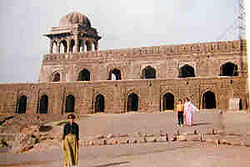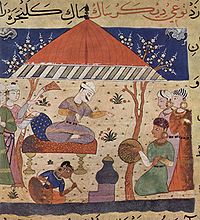
Malwa Sultanate
Encyclopedia

Madhya Pradesh
Madhya Pradesh , often called the Heart of India, is a state in central India. Its capital is Bhopal and Indore is the largest city....
state in India
India
India , officially the Republic of India , is a country in South Asia. It is the seventh-largest country by geographical area, the second-most populous country with over 1.2 billion people, and the most populous democracy in the world...
in 1392–1562.
History
For earlier history, see article Malwa.The sultanate of Malwa was founded by Dilawar Khan Ghuri
Dilawar Khan
Dilāwar Khān Ghaurī or Dilāwar Khān Ghōrī was governor of the Malwa province of central India during the decline of the Delhi Sultanate. After serving at the court in Delhi, he was appointed governor at Dhar in A.H. 793/C.E. 1390-91. Dilāwar Khān took the title of 'Amid Shāh Dā'ūd and caused the...
, the governor of the Delhi Sultanate
Delhi Sultanate
The Delhi Sultanate is a term used to cover five short-lived, Delhi based kingdoms or sultanates, of Turkic origin in medieval India. The sultanates ruled from Delhi between 1206 and 1526, when the last was replaced by the Mughal dynasty...
in Malwa, who asserted his independence in 1392, but did not actually assume the ensigns of royalty till 1401. Initially Dhar
Dhar
Dhār is located in the Malwa region of western Madhya Pradesh state in central India. It is the administrative headquarters of Dhar District. The town is located west of Mhow, above sea level...
was the capital of the new kingdom, but soon it was shifted to Mandu
Mandu
Mandu or Mandavgad is a ruined city in the Dhar district in the Malwa region of western Madhya Pradesh state, central India. The distance between Dhar & Mandu is about 35 km. In the 11th century, Mandu was the sub division of the Tarangagadh or Taranga kingdom...
which was renamed Shadiabad (the city of joy). After his death, he was succeeded by his son Alp Khan, who assumed the title of Hoshang Shah. The Ghuri dynasty founded by Dilawar Khan Ghuri was replaced by Mahmud Shah I, who proclaimed himself king on May 16, 1436. The Khilji dynasty founded by him ruled over Malwa till 1531. Mahmud I was succeeded by his eldest son Ghiyas-ud-Din. The last days of Ghiyas-ud-Din was embittered by a struggle for throne between his two sons, Nasir-ud-Din and Ala-ud-Din. Nasir-ud-Din, however emerged victorious and ascended the throne on October 22, 1500. The last ruler Mahmud Shah II surrendered to Bahadur Shah, the sultan of Gujarat after the fort of Mandu fell to Bahadur on May 25, 1531.
During 1531 – 1537 the kingdom was under the control of Bahadur Shah though the Mughal emperor Humayun
Humayun
Nasir ud-din Muhammad Humayun was the second Mughal Emperor who ruled present day Afghanistan, Pakistan, and parts of northern India from 1530–1540 and again from 1555–1556. Like his father, Babur, he lost his kingdom early, but with Persian aid, he eventually regained an even larger one...
captured it for a short period during 1535-36. In 1537, Qadir Shah, an ex-officer of the previous Khilji dynasty rulers regained control over a part of the erstwhile kingdom. But in 1542, Sher Shah Suri
Sher Shah Suri
Sher Shah Suri , birth name Farid Khan, also known as Sher Khan , was the founder of the short-lived Sur Empire in northern India, with its capital at Delhi, before its demise in the hands of the resurgent Mughal Empire...
conquered the kingdom defeating him and appointed Shuja'at Khan as the governor. His son, Baz Bahadur declared himself independent in 1555. In 1561, Akbar's army led by Adham Khan
Adham Khan
Adham Khan was a general of Akbar. He was the younger son of Maham Anga, he thus became the foster brother of Akbar. In his fourth regnal year, Akbar married him to the daughter of Baqi Khan Baqlani.-Conquest of Malwa:...
and Pir Muhammad Khan attacked Malwa and defeated Baz Bahadur in the battle of Sarangpur on 29 March, 1561. Akbar, soon recalled Adham Khan and made over command to Pir Muhammad. Pir Muhammad attacked Khandesh and proceeded up to Burhanpur
Burhanpur
Burhanpur is an important city in Madhya Pradesh state, India. It is the administrative seat of Burhanpur District. It is situated on the north bank of the Tapti River, southwest of Bhopal and northeast of Mumbai...
but he was defeated by a coalition of three powers: Miran Mubarak Shah II of Khandesh
Khandesh
Khandesh is a region of central India, which forms the northwestern portion of Maharashtra state.Khandesh was the terminal territorial part under the rule of Mughals. The Start of Deccan region demarcated by the boundary of Khandesh....
, Tufal Khan of Berar
Berar Sultanate
-Berar in Ancient History:Subah Berar and Gondwana the Vidarbha region known as Gulshan-e-Berar in medieval period since Khilji dynasty to mughal period according Aine-Akbari and Alimgeer Namah report the berar is hole Fourteen sarkar...
and Baz Bahadur. Pir Muhammad died while retreating. The confederate army pursued the Mughals and drove them out of Malwa. Baz Bahadur regained his kingdom for a short period. In 1562, Akbar sent another army led by Abdullah Khan, the Uzbeg, which finally defeated Baz Bahadur. He fled to Chittor. It became a Subah
Subah
A Subah was a province of the Mughal Empire in South Asia. The governor of a subah was known as a subahdar, which later became subedar to refer to an officer in the Indian Army...
of the Mughal empire and Abdullah Khan became its first governor.
Art and Architecture

Malwa painting
Many remarkable illustrated manuscripts were prepared during the period of the sultanate. An illustrated manuscript of Kalpa Sutra (1439) (presently in the National Museum, Delhi) was prepared in Mandu during the reign of Mahmud Shah I But the most interesting is a manuscript of the Nimat Nama, a treatise on the art of cooking, which bears many portraits of Ghiyas-ud-Din Shah but the colophon bears the name of Nasir-ud-Din Shah. The other notable illustrated manuscripts of this period are of the Miftah-ul-Fuzala, a dictionary of rare words, the Bustan (1502) painted by Haji Mahmud and the Aja'ib-us-San'ati (1508). Another manuscript of the Anwar-i-Suhaili (now in the National Museum, Delhi) probably also belong to this period.Malwa architecture
The monuments built during the sultanate period are almost concentrated in Mandu city. The early monuments were assembled out of the materials of earlier Hindu temples, according to the Islamic plan and convention. But nothing seems to have been done to conceal or alter their essential Hindu appearance. The significant among them are the Kamal Maula Masjid (c.1400), the Lal Masjid (1405), Dilawar Khan's Masjid (c.1405) and the Masjid of Malik Mughis (1452) in Mandu.
Firishta
Firishta or Ferishta, full name Muhammad Qasim Hindu Shah , was born in 1560 and died in 1620 and he was a Persian historian. The name Firishta means angel or one who is sent in Persian.-Life:...
, the tomb of Hoshang Shah was built by Mahmud Shah I. The later mausoleums, such as the tomb of Darya Khan, the Dai ka Mahal and the Chhappan Mahal were built on the same design. A long structural complex situated between two lakes has a curious name, the Jahaz Mahal (ship-palace). Though the date of this monument is not definitely known, its general style is in accord with the character of Ghiyas-ud-Din Khilji. A lonely building on the slope of a hill by the side of Riwa Kund is known by the local people as Baz Bahadur's palace. According to an inscription this monument was actually built by Nasir-ud-Din Shah. The Rani Rupmati Pavilion stands on the southern edge of the plateau and as its situation and form indicate, was, in all probability, designed for military purposes.
The rulers
The Ghuri dynasty (1401–36)
- Dilawar KhanDilawar KhanDilāwar Khān Ghaurī or Dilāwar Khān Ghōrī was governor of the Malwa province of central India during the decline of the Delhi Sultanate. After serving at the court in Delhi, he was appointed governor at Dhar in A.H. 793/C.E. 1390-91. Dilāwar Khān took the title of 'Amid Shāh Dā'ūd and caused the...
1401–1406 - Husam-ud-Din Hoshang ShahHoshang ShahOriginally known as Alp Khan, he had taken the title of Hoshang Shah or Hushang Shah Gori, when he was crowned the second King of Malwa. Alp Khan's father Dilawar Khan Ghori had belonged to the court of Firozshah Tughlaq, the Sultan of Delhi...
1406–1432 - Taj-ud-Din Muhammad Shah I 1432–1436
The Khilji dyansty (1436–1531)
- Ala-ud-Din Mahmud Shah I 1436–1469
- Ghiyas-ud-Din Shah 1469–1500
- Nasir-ud-Din Shah 1500–1510
- Shihab-ud-Din Mahmud Shah II 1510–1531
- Ibrahim Lodi (Delhi sultan) 1511
- Muhammad Shah II (rebel) 1510–1516
The intermission
- Bahadur Shah (the sultan of Gujarat) 1531–1537
- HumayunHumayunNasir ud-din Muhammad Humayun was the second Mughal Emperor who ruled present day Afghanistan, Pakistan, and parts of northern India from 1530–1540 and again from 1555–1556. Like his father, Babur, he lost his kingdom early, but with Persian aid, he eventually regained an even larger one...
(Mughal emperor) 1535–1536
The later rulers
- Qadir Shah 1537–1542
- Shuja'at Khan (the governor of Sher Shah Suri) 1542–1555
- Baz BahadurBaz BahadurMiyan Bayezid Baz Bahadur was the last sultan of Malwa, who reigned from 1555 to 1562. He succeeded his father, Shuja'at Khan. He is known for his romantic liaison with Roopmati, a singer of Rajput birth....
1555–1561

